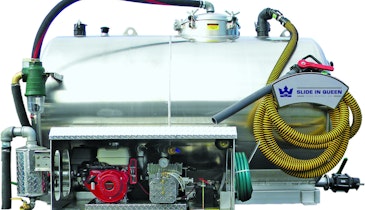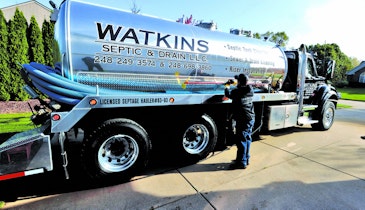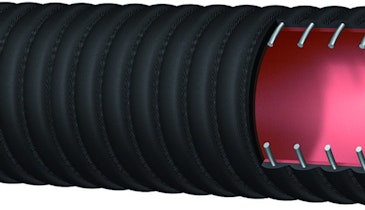Farmers in northeast Lower Michigan watched Richard Gillespie of Alpena Septic Service grow corn and alfalfa on mediocre sandy loam soils after land-applying the wastewater he pumped. They couldn’t raise those crops without using tons of costly nitrogen fertilizer and wanted to substitute some septage, but Gillespie turned them down. The demand far outstripped his supply.
Richard and Lynn Gillespie are pumpers who elected to stay on the land by building a septage storage facility that meets 2004 Michigan Department of Environmental Quality, or MDEQ, regulations. They joined the Michigan Septic Tank Association to have a voice in future septage regulations. Richard Gillespie is on the association’s board of directors. “We want state legislators to understand that recycling wastewater benefits farmers and lowers pumping prices for consumers,” says Gillespie.
To emphasize his professional commitment, Gillespie became a NAWT-certified inspector and installer. Faced with a sluggish economy in the area, the couple found ways to grow their business through diversified services. Although Michigan’s pumping industry is in transition, Richard and Lynn Gillespie are leading by example and ready for any challenges ahead.
Pivotal year
Lynn Gillespie, who pumped septic tanks and portable restrooms for her father, opened her own business in October 1997 after she and Richard married and had customers before she owned a truck. They spent their honeymoon driving to New Jersey to buy a 1981 International vacuum truck with 2,800-gallon steel tank.
Believing portable restrooms could be profitable, they purchased 10 units in 2000. Richard Gillespie built a folding hydraulic platform on the back of the vacuum pumper to transport them. He coupled a 2-inch hose to the 3-inch sewage hose so his wife could reach and clean the restrooms.
While Gillespie built homes and did excavating, she pumped tanks and portable restrooms in a 50-mile that included Alpena, Alcona, Montmorency and Oscoda counties. In 2004, he joined the business, becoming a NAWT- certified pumper. His ability to troubleshoot systems soon earned him the nickname Septic Doctor.
The couple began enlarging their portable restroom inventory in January 2004. Lynn Gillespie spent months calling special event organizers, township park departments, and building contractors. “That spring, we had more business than potties,” she says. They purchased 20 Aspen units from Five Peaks Technology and 80 Taurus and eight World Care handicap units from Synergy World. Lynn Gillespie’s sister, Roxanne Golder, helps her service them.
Disposal challenges
Alpena Septic’s pumping accounts are 85 percent residential and 15 percent commercial. The latter are all restaurants, mostly with commingled septic systems. The area has primarily cottage industries with many seasonal dwellings near Lake Huron.
“Everything changed when the MDEQ revised septage disposal regulations became law in 2004,” says Richard Gillespie. “They greatly restrict what haulers can do. For example, we can’t pump car washes unless we have an industrial waste-hauling license. We must commingle two-thirds septage with one-third grease trap waste to land-apply it, so we don’t pump grease traps.”
The rules also state that septage pumped within 15 radial miles of a DEQ-approved receiving facility must be discharged there. Beginning in the winter of 2007-08, it became illegal to apply septage during a winter period set by the state. No state allows farmers and haulers to apply septage or liquid manure if the soil is frozen, but Gillespie argues that soil is often insulated by snow cover in the winter, preserving favorable conditions for injecting septage.
“With the soil often well above freezing, it’s radiating heat and melting the snow,” says Gillespie. “Injecting septage prevents runoff and erosion. The liquid still seeps down and the soil treats it. Injecting also builds up organic matter and creates structure, which further reduces runoff and erosion. Our association is trying to help the MDEQ understand those scientific principles.”
Haulers without storage facilities had to stop pumping or discharge at municipal plants, forfeiting their land sites in the process.
Rolling the dice
In 2007, the couple made a financial commitment and purchased a glass-lined, 100,000-gallon steel storage tank from Slurry Store Co. It can be expanded to 300,000 gallons by building up the sides. A mandatory bar screen with 3/8-inch gaps separates debris from the septage.
A time limit made the venture risky. As long as their storage facility or plans to build it were approved before the municipal plant in the area was ready to accept septage, the couple could land-apply until 2025. “We began planning our facility in 2004, had the plans approved at the local level in 2005, then waited to see what happened,” says Gillespie.
The nearest treatment plant in Oscoda, 32 miles away, didn’t accept septage until 2006. The City of Alpena’s updated treatment plant will come online sometime in 2008, but officials aren’t stating the discharge fee.
In 2006, before the Oscoda plant began accepting septage, the MDEQ approved the plans for Alpena Septic Service’s storage facility. The Gillespies built the facility themselves.
As soon as haulers gave up their land sites, the plant south of Alpena raised its discharge fee from $55 per 1,000 gallons to $80 in 2007. It increased to $110 per thousand early this year. “Treatment plants have realized the revenue that’s out there and are increasing their rates so they will have ample money to modify their facilities to accept septage,” says Gillespie.
Haulers are passing those rate hikes onto customers. Gillespie estimates that it costs him less than $35 a thousand to dispose of his septic waste. This price discrepancy has created cutthroat competition for the region’s meager customer base.
Rising fees
Because the area is economically depressed, analyzing competition is based on population. Alpena County, with 30,000 people, has four haulers. Alcona County, with 10,000 people, has three haulers, two of which discharge at municipalities. Alpena Septic Service is probably the second largest company in the region.
The couple land-apply on a 130-acre site and a 40-acre site. Gillespie would like to accommodate more farmers, but can’t afford the $500 permit fee per site. “My hauler’s license increased from $125 a year to $1,600 in 2006,” Gillespie says. “The state charges more per vehicle if you land-apply.”
The law states that haulers are responsible for what happens to the septage, and that it must be incorporated within six hours of being applied unless it is lime stabilized. Rather than rely on a farmer, the couple bought a disk, springtooth harrow, and John Deere tractor to incorporate the slurry. Gillespie adds lime to the storage tank to stabilize the slurry, enabling greater surface application on alfalfa fields. He pays a man to plant his corn. Controlling farm operations has proven very time consuming for Gillespie.
Out in front
One investment that is paying off is the 2002 Mack Vision Series vacuum truck they bought in 2006 from 27th Trucks Inc. The couple can transport more waste and the fuel economy is better than on the smaller International. The Mack sports a 460-cubic inch E/7 engine coupled with a 10-speed Eaton-Fuller transmission. It has a 4,200-gallon steel tank and Jurop 150 water-cooled pump. A drop axle allows hauling a minimum of 1,500 gallons when spring weight limits are enforced.
As an advertising vehicle, the truck is helping increase their customer base. “Everything we own is painted metallic forest green and white,” says Lynn Gillespie. “People identify the company by those colors.” Answering calls on weekends and word-of-mouth references are other ways they compete for business.
Providing quality service — doing things other pumpers don’t do — is another way the couple is expanding their customer base. As a NAWT-certified inspector, Richard Gillespie is trained to look for many different things. “I often won’t pump the tank if other issues are causing the problem,” he says. “I alert the homeowner and fix what is wrong. Although the process is slow, these people do become my customers.”
Besides troubleshooting, Gillespie also replaces lines and installs risers and effluent filters. He has time to install only 20 onsite systems a year. Inspecting systems accounts for 10 percent of the company’s profit.
Another way the couple increases its customer base is by educating homeowners on how to maintain septic systems. Besides golden backyard opportunities, they rent a booth at an annual home show, where Richard Gillespie presents a program on operation and maintenance.
“People are starving for the information. After Richard’s session, many in the audience follow him back to our booth. Most become our customers,’’ says Lynn Gillespie. The couple ordered educational videos from the Pennsylvania Septage Management Association and shows them at the booth. “People actually sit and watch them,” she says.
Just call him the Septic Doctor
Richard Gillespie of Alpena Septic Service in Spruce, Mich., knows so much about troubleshooting onsite system problems, septic customers now refer to him as the Septic Doctor. The National Association of Wastewater Transporters Inc. certified inspector has run into some interesting case studies in recent years.
His most bizarre case involved a homeowner who had his septic tank pumped every two years, yet one day it backed up. The man showed Gillespie a 6-inch cleanout port in the garage floor, but the liquid he examined was effluent water. “We have a lot of dry wells in the area, and this is what the hauler had been pumping,” he says.
Gillespie couldn’t use his electronic locator to find the septic tank because the lateral was plugged and the house had no cleanouts. He and his wife, Lynn, a septic hauler, excavated beside the two-car garage and used long probes to calculate measurements. They chalked the tank’s projected location on the garage floor, then sawed out a 24-inch-square concrete slab.
“To our amazement, we hit the cover,” says Gillespie. “We were off center by 3 inches, but were able to remove the lid and pump the tank for the first time in 13 years.” Gillespie installed a riser and replaced the slab. Since the system wasn’t up to that health district’s code, the homeowner was told to replace it.
A recent episode involved a lake home with a wrap-around deck. An inspector had passed the onsite system two years ago when the property was sold. Now sewage was backing up. When Gillespie arrived to pump the tank, he couldn’t find it. “The soil is glacial till — boulders, stone, and clay — and it’s impossible to stick a probe in the ground,” he says. “It’s hard to dig even with a backhoe.”
Gillespie sent his sonde down the toilet and found the tank buried beneath the deck. “It was quite a battle to uncover it, because the deck’s structural supports were over the lid,” he says. “No one had pumped that tank in years. The inspector had charged the homeowner for pumping what he stated was the required two-compartment, 500-gallon tank. Gillespie pumped the tank and estimated its capacity at 300 gallons.
When he flushed the toilet, water flowed into the tank, but nothing happened when he flushed the second toilet. Sending down the sonde, he found another 300-gallon tank 60 feet away on the opposite side of the house. The deck’s structural supports were over that lid, too.
“Nothing in this system would have passed the local health district’s sanitary code,” he says. “Sadly, such inspections are common in Michigan.” The homeowner spent $5,000 bringing his “passed” system up to code.
Standardizing the code
Richard Gillespie says that the biggest challenge facing haulers is establishing a standardized septic code. “We have about 80 different sets of rules throughout the state,” he says.
Developing a state certification program is the next hurdle. “I took the NAWT installer certification test in 2006, but that piece of paper means nothing here because the state doesn’t require any certification,” Gillespie continues.
The Gillespies remain committed to staying on the land, recycling waste responsibly, and working to make legislation more amenable to haulers. The next phase of their growth plan is to hire a full-time employee. “Taking some time off after years of working around the clock will make a huge difference in our lives,” says Gillespie. “We’ll finally be able to enjoy the fruits of our labors.”





